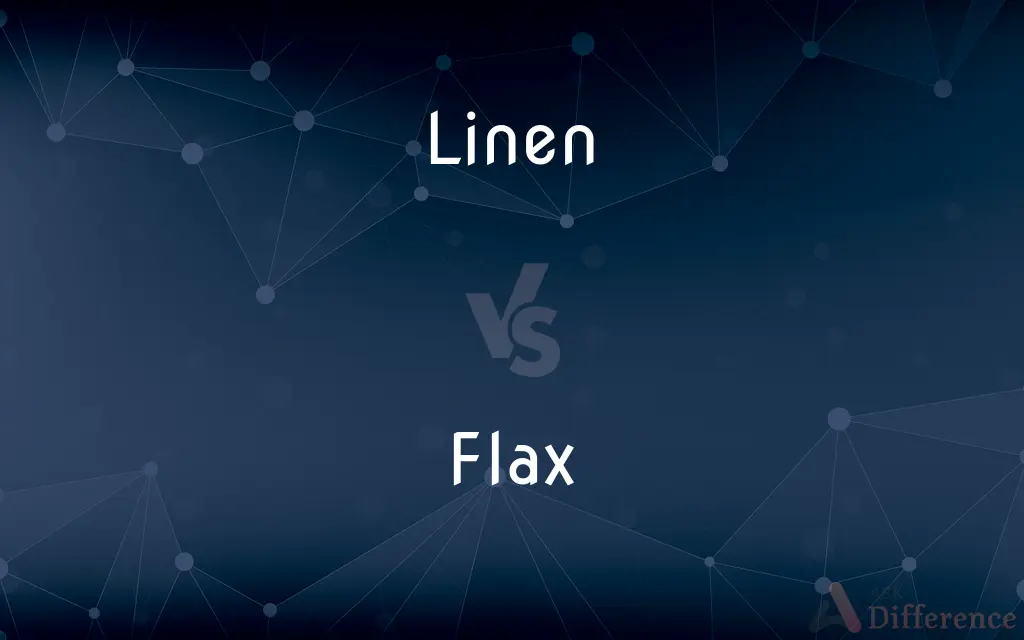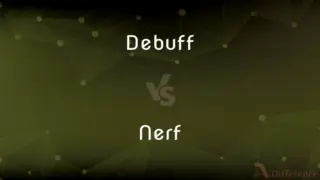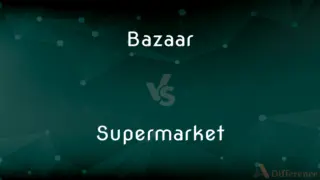Linen vs. Flax — What's the Difference?
By Maham Liaqat & Fiza Rafique — Updated on March 21, 2024
Linen is a textile made from flax fibers, while flax refers to the plant itself, used for both fabric production and as a food source.

Difference Between Linen and Flax
Table of Contents
ADVERTISEMENT
Key Differences
Linen is a durable, natural fiber textile made from the stalks of the flax plant. On the other hand, flax is a versatile crop known for its seeds, which are rich in nutrients, and its fibers, which are used to make linen.
The process of turning flax into linen involves several steps, including retting, scutching, and spinning, which separate the fibers from the rest of the plant and prepare them for weaving. Whereas, the cultivation of flax focuses on growing the plant to maturity, ensuring it's suitable for either fiber extraction for linen or seed production.
Linen is celebrated for its breathability, strength, and ability to wick moisture away from the body, making it a popular choice for clothing and bedding, especially in warm climates. Flax seeds, however, are highly regarded for their nutritional benefits, including being a rich source of omega-3 fatty acids, fiber, and antioxidants.
The environmental impact of linen and flax also differs. Linen, when produced sustainably, can be a more eco-friendly textile option, as flax requires fewer pesticides and water than cotton. The cultivation of flax, particularly for seeds, has additional environmental considerations, including the use of land and resources for crop production.
In the market, linen products are often associated with higher quality and cost, reflecting the labor-intensive process of linen production. Flax, as a raw material, is comparatively less expensive but plays a crucial role in various industries beyond textiles, such as in health foods and supplements.
ADVERTISEMENT
Comparison Chart
Source
Made from the fibers of the flax plant.
The plant itself.
Use
Textile production for clothing, bedding, etc.
Seeds for food, fibers for textiles.
Processing
Involves retting, scutching, and spinning.
Cultivated for seed or fiber production.
Benefits
Breathable, strong, moisture-wicking.
Nutritional value in seeds, eco-friendly fiber source.
Environmental Impact
Eco-friendly when produced sustainably.
Requires fewer pesticides and less water than cotton.
Compare with Definitions
Linen
Eco-Friendly Textile Choice.
Linen is produced with minimal chemical usage.
Flax
Versatile Crop.
Flax is cultivated for both its seeds and fibers.
Linen
Labor-Intensive Production.
The production of linen involves multiple manual processes.
Flax
Requires Less Water and Pesticides.
Flax cultivation is relatively eco-friendly.
Linen
Breathable and Moisture-Wicking.
Linen bedding is preferred in summer for its coolness.
Flax
Nutritional Seeds.
Flax seeds are a great source of omega-3 fatty acids.
Linen
Associated with Luxury.
Due to its complex production, linen products are often high-end.
Flax
Foundation of Linen Production
Without flax, there would be no linen textiles.
Linen
Made from Flax Fibers.
Linen shirts are known for their durability and comfort.
Flax
Used in Textile and Food Industry.
Besides linen, flax seeds are used in health foods.
Linen
Linen () is a textile made from the fibers of the flax plant. Linen is very strong, absorbent, and dries faster than cotton.
Flax
Flax, also known as common flax or linseed, is a flowering plant, Linum usitatissimum, in the family Linaceae. It is cultivated as a food and fiber crop in regions of the world with temperate climate.
Linen
Cloth woven from flax
A linen suit
He dealt in Irish linens
Flax
A widely cultivated plant, Linum usitatissimum, having pale blue flowers, seeds that yield linseed oil, and slender stems from which a textile fiber is obtained.
Linen
Thread made from fibers of the flax plant.
Flax
The fine, light-colored textile fiber obtained from this plant.
Linen
Cloth woven from this thread.
Flax
Any of various other plants of the genus Linum or of other genera in the family Linaceae.
Linen
Also linens Articles or garments, such as sheets, tablecloths, or underwear, formerly made of linen and now usually made of other fabrics, especially cotton.
Flax
A pale grayish yellow.
Linen
Paper made from flax fibers or having a linenlike luster.
Flax
A plant of the genus Linum, especially Linum usitatissimum, which has a single, slender stalk, about a foot and a half high, with blue flowers. Also known as linseed, especially when referring to the seeds.
Linen
Made of flax or linen.
Flax
The fibers of Linum usitatissimum, grown to make linen and related textiles.
Linen
Resembling linen.
Flax
The flax bush, a plant of the genus Phormium, native to New Zealand, with strap-like leaves up to 3 metres long that grow in clumps.
Linen
(uncountable) Thread or cloth made from flax fiber.
Flax
A plant of the genus Linum, esp. the L. usitatissimum, which has a single, slender stalk, about a foot and a half high, with blue flowers. The fiber of the bark is used for making thread and cloth, called linen, cambric, lawn, lace, etc. Linseed oil is expressed from the seed.
Linen
(countable) Domestic textiles, such as tablecloths, bedding, towels, underclothes, etc., that are made of linen or linen-like fabrics of cotton or other fibers; linens.
She put the freshly cleaned linens into the linen closet.
Flax
The skin or fibrous part of the flax plant, when broken and cleaned by hatcheling or combing.
Linen
A light beige colour, like that of linen cloth undyed.
Flax
Fiber of the flax plant that is made into thread and woven into linen fabric
Linen
Made from linen cloth or thread.
Flax
Plant of the genus Linum that is cultivated for its seeds and for the fibers of its stem
Linen
Having the colour linen, light beige.
Linen
Made of linen; as, linen cloth; a linen stocking.
Linen
Resembling linen cloth; white; pale.
Linen
Thread or cloth made of flax or (rarely) of hemp; - used in a general sense to include cambric, shirting, sheeting, towels, tablecloths, etc.; as, bed linens
Linen
Underclothing, esp. the shirt, as being, in former times, chiefly made of linen.
Linen
A fabric woven with fibers from the flax plant
Linen
A high-quality paper made of linen fibers or with a linen finish
Linen
White goods or clothing made with linen cloth
Common Curiosities
What is linen made from?
Linen is made from the fibers of the flax plant.
What makes flax seeds beneficial?
They are high in omega-3 fatty acids, fiber, and antioxidants.
How is flax used besides textile production?
Flax is used for its seeds, which are rich in nutrients, and in health food products.
Can flax grow in any climate?
Flax is adaptable but thrives best in cooler climates.
Why is linen considered luxurious?
Due to its labor-intensive production process and quality.
What are the main uses of flax?
For producing linen and harvesting seeds for nutritional purposes.
Are there different types of linen?
Yes, linen can vary in texture and weave, affecting its appearance and feel.
Is linen environmentally friendly?
Yes, linen can be an eco-friendly textile choice when produced sustainably.
Can linen be recycled?
Yes, linen is biodegradable and can be recycled or composted.
How does the production of linen impact the environment?
It's generally low impact, requiring fewer pesticides and less water than many other crops.
Why choose linen over other textiles?
For its durability, moisture-wicking properties, and environmental benefits.
How are flax seeds consumed?
Ground, whole, or as oil in various foods and supplements.
Is all linen produced from flax?
Yes, true linen is specifically made from flax fibers.
What's the difference in maintenance between linen and other fabrics?
Linen requires gentle washing and can be more prone to wrinkling.
What is the historical significance of linen?
Linen is one of the oldest textiles, valued for thousands of years for its durability and comfort.
Share Your Discovery

Previous Comparison
Debuff vs. Nerf
Next Comparison
Bazaar vs. SupermarketAuthor Spotlight
Written by
Maham LiaqatCo-written by
Fiza RafiqueFiza Rafique is a skilled content writer at AskDifference.com, where she meticulously refines and enhances written pieces. Drawing from her vast editorial expertise, Fiza ensures clarity, accuracy, and precision in every article. Passionate about language, she continually seeks to elevate the quality of content for readers worldwide.














































